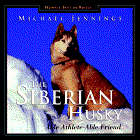RSH Racing Editor:
Following up on the first question, please explain how you go about gauging
what basic pace is possible for a particular group of dogs you want to work with?
Jim Welch: I don't know of any practical way to objectively measure
a dog team's best pace potential. Comparison to other dogs, dog teams and performance
criteria has to be the rule of thumb.
Since I personally do not deal with an entirely new group of dogs at
the start of every season, I know my core dogs' capabilities and can compare the new dogs
to see how they fit in. I know who is fastest and who is most enduring and can compare new
dogs to those.
I look for their willingness and ability to keep a tight tug at the start of the
season, when we're going short miles pulling a non-motorized heavy cart (e.g., a big
4-wheeler with the motor turned off). I want to know how smooth and efficient their gait
is, how long the stride is. Is the tugline tight when they take off with the hind end as
well as when they land with the front? Is there any period in the stride when the tug
slacks even for an instant (jerk running)? Can they work hard and yet do it easily?
If a dog runs with no wasted motion, is smooth-gaited at a run
with a tight tugline throughout the stride, it will likely be fast.
I think you have to see an example of what a gifted dog's gait looks like to really
understand this seeming paradox of working hard and yet doing it easily. You will never
forget, and never be able to kid yourself again. If a dogs runs with no wasted motion, is
smooth-gaited at a run with a tight tugline throughout the stride, it will likely be fast.
As probably all your readers know, the so-called "show trot" tells nothing
about how well a dog will perform nor how fast he will run.
Next I compare their fatigue level and recovery time at the end of a run. Are the dogs
panting so hard that you could look down their throat like it is a wide-open mine shaft?
Do they stop panting about the same time that other dogs do, or do they take longer to
recover? Are they wobbly and weak? You can have dogs that try very hard to do as well as
the rest, but just don't have the physical talent.
Are the dogs panting so hard that you could look down their
throat like it is a wide-open mine shaft?
I have a soft spot for dogs like this. They will give everything they've got for you.
It's not their fault they don't have the natural gifts, but if you are honest you ask, how
do they compare to the rest of the team? Recovery time can be a good indication of fitness
relative to the rest of the dogs in the group.
If I were starting from scratch with an entirely new group of dogs, I would build their
condition from scratch, pulling heavy loads for short distances (a couple of miles). The
load would be heavy enough so that they could maintain a slow lope. I would evaluate their
gaits and the tugline status and look at all the factors mentioned above. If after no more
than a month of this they looked good, I would start letting them run pulling light sleds
distances that they could do easily and fast. I would give them the opportunity to show
what they can do on their own.
From there, I would go step by step, training them and culling when individuals cannot
match what the rest of the team is able to do. I can time some segments of a training
trail I know to see what their comfortable pace is and judge from that how they compare to
other teams in other years. I try not to be too theoretical. If the dog does the job, I
give him/her the benefit of the doubt until it shows that the dog can't make the grade.
A well conditioned dog teams needs to be capable of maintaining a basic pace in excess
of
